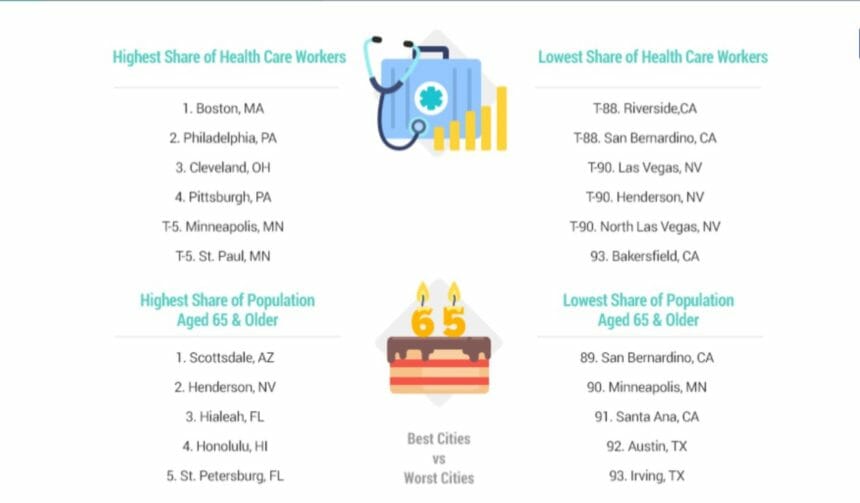
With the Food and Drug Administration’s vaccine advisory board recommending approval of the Pfizer-BioNTech COVID-19 vaccine for emergency use authorization on Thursday, two data analyses outline which states and cities are in need of the most vaccines to target initial priority populations.
The Kaiser Family Foundation analyzed national and state-level data to estimate the number of healthcare workers and long-term care residents identified as priority groups by the Centers for Disease Control and Prevention’s Advisory Committee on Immunization Practices.
Nationwide, KFF identified 19.7 million adults working in healthcare settings, with approximately 15.5 million having direct resident/patient contact. In addition, there are 800,000 assisted living community residents and 1.2 million skilled nursing facility residents. Together, these populations account for approximately 17.6 million people, or about 7% of the U.S. adult population.
Based on the estimated number of healthcare workers and skilled nursing facility residents in 2019, the analysis found that the states with the highest percentages of priority populations as a share of total adults include North Dakota (10%); Pennsylvania (8.3%); Minnesota and Rhode Island (8.1% each); and Massachusetts, New York and Ohio (8% each).
The states with the largest number of people in those groups, however, are California (1.7 million), Texas (1.3 million), New York (1.2 million) and Florida (1.1. million).
40 million doses by end of year
The Department of Health and Human Services has said that it will have approximately 40 million doses of vaccine available by the end of the year — enough to vaccinate approximately 20 million people. Both the Pfizer and the Moderna vaccines require two doses.
Although states have the authority to make their own allocation decisions, most are expected to follow the ACIP guidelines for initial priority groups. HHS said it plans to allocate vaccines based on each state’s share of the total U.S. adult population.
“Variations in the number of healthcare workers and long-term care residents across states may result in uneven effects across states in their ability to immunize priority populations using their initial vaccine allotments,” the KFF analysis stated. “While some states may have an adequate supply to vaccinate their priority population, others may fall short and may need to decide who goes first among people in this initial group.”
The KFF analysis added that as states allocate vaccines down to the local level, the ability of counties, municipalities and healthcare systems to vaccinate healthcare workers and long-term care residents could vary depending on their vaccine supply and community demographics.
In its priority recommendations for vaccination, the ACIP also released guidelines indicating that where vaccine supply is insufficient, jurisdictions may consider first vaccinating healthcare personnel. In settings where the initial vaccine supply is insufficient to vaccinate all healthcare personnel, the ACIP noted that sub-prioritization may be necessary, pushing healthcare workers with direct resident/patient contact and those working in residential care communities or other long-term care facilities to the front of the line.
Although assisted living residents are included in the first priority group, ACIP said that skilled nursing facilities should be prioritized among long-term care facilities if vaccine supply is limited, due to the risk of COVID-19 mortality among residents in such settings.
KFF based its analysis on the 2019 American Community Survey for estimates on healthcare workers, the 2016 Study of Long-Term Care Providers data for nationwide estimates of assisted living residents, and the 2019 Certification and Survey Provider Enhanced Reports data for nursing facilities. State-level data excluded residents of assisted living communities and other residential care settings.
Ranking cities by vaccination need
Meanwhile, WalletHub compared more than 90 large cities across 13 metrics to determine the cities that will need the most initial supply of COVID-19 vaccines.
The ranking looked at each city’s share of frontline healthcare workers, the population of adults aged 65 or more years, essential workers and rates of chronic disease to rank cities according to need.
According to the WalletHub report, cities that need the highest number of vaccine doses initially are Detroit; Cleveland; Birmingham, AL; Memphis, TN; Louisville, KY; Toledo, OH; Baton Rouge, LA; Buffalo, NY; Cincinnati; and Newark, NJ.
Cities with the highest concentration of healthcare workers are Boston; Philadelphia; Cleveland; Pittsburgh; and Minneapolis and St. Paul, MN, which tied for fifth place. On the flip side, cities with the lowest share of healthcare workers are Riverside, CA, and San Bernardino, CA, which tied for 88th place; Las Vegas, Henderson and North Las Vegas, NV, which tied for 90th place; and Bakersfield, CA.
Cities with the largest population of residents 65 and older are Scottsdale, AZ; Henderson, NV; Hialeah, FL; Honolulu; and St. Petersburg, FL. The youngest cities are San Bernardino, CA; Minneapolis; Santa Ana, CA; Austin, TX; and Irving, TX.
The report also looked at cities with the highest share of individuals with chronic diseases, including chronic kidney disease, cardiovascular disease, diabetes, chronic obstructive pulmonary disease, asthma, hypertension and obesity. Detroit, Cleveland and Birmingham had the highest populations of residents with chronic illness.
WalletHub used data from the U.S. Census Bureau, CDC and Centers for Medicare & Medicaid Services to create rankings based on total U.S. adult population.




